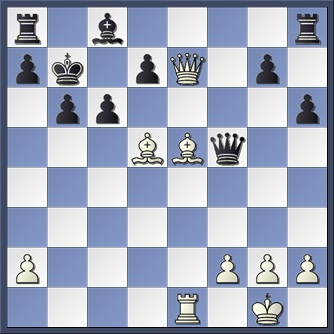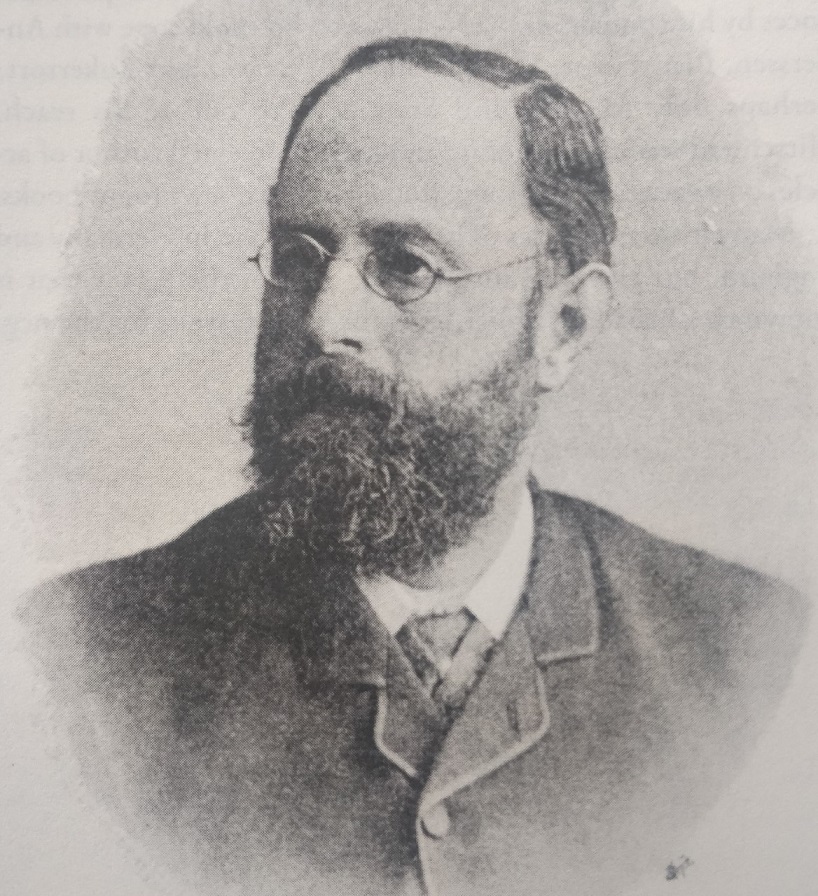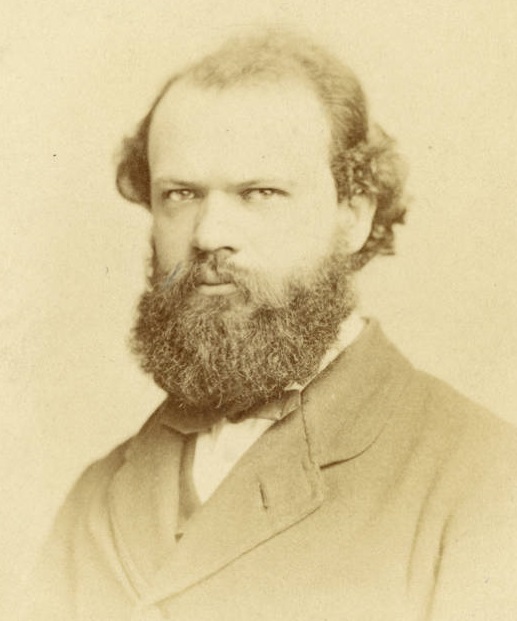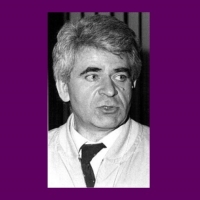Neumann, Hirschfeld and Suhle
19th Century Berlin Chess Biographies with 711 Games
Hans Renette and Fabrizio Zavatarelli
384 pages | hardback | 66 illustrations | 711 games | $75.00
Jefferson: McFarland, 2018
Jonathan Hinton
Collectors of modern books on chess history, particularly those by the renowned North Carolinan publishing house McFarland & Co, need to have sturdy bookshelves. In my study the shelf allocated to these titles has a noticeable sag in the middle as the considerable weight of the volumes takes its toll. The two heavyweights are undoubtedly Skinner and Verhoeven’s magnificent Alekhine book1 and Richard Forster’s monumental biography of Burn.2 These McFarland titles weigh in at 2.2 kg and 2.5 kg respectively.
Weighing a mere 1.15 kg is another McFarland tome, written jointly by Hans Renette and Fabrizio Zavatarelli. It is nevertheless an impressive 376-page cloth-bound collection of biographies of three players who were active in Berlin during the middle of the nineteenth century. The genesis of the collaboration is interesting: in 2015 Renette and Zavatarelli became aware that they were each undertaking biographies of players who were active at the same time in Berlin. Renette was researching Gustav Neumann (1838−1881) while Zavatarelli was writing about Philipp Hirschfeld (1840−1896) and Berthold Suhle (1837−1904). The authors decided to collaborate to produce a combined set of related biographies. Zavatarelli also wrote two other parts of the book – an introductory chapter covering chess in Berlin before 1860, and an appendix on another fascinating figure of Berlin chess, Bernhard von Guretzky-Cornitz (1838−1873), a contemporary of the three main characters.
I have a keen interest in chess history but confess that I knew little of Neumann beyond the fact that he was a regular and strong partner of Adolf Anderssen (1818−1879) and that he had scored an impressive result in one of the early all-play-all tournaments at Baden-Baden, 1870. I knew even less of Hirschfeld and Suhle, only recognising them as opponents of Anderssen. So does this book educate and enlighten us on these players? It turns out that they were very well-known and highly respected masters in their time – indeed even rivalling Anderssen, Paulsen, Kolisch and Steinitz.
Paul Bilguer
Part I is the above-mentioned supplementary chapter on pre-1860 Berlin chess. As the authors point out, it is a vast subject and warrants a separate book to do it justice. Nonetheless, in twenty pages or so Zavatarelli manages to provide an overview of the development of chess activity in the city and gives brief biographical sketches of the prominent players. You might never have heard of Wilhelm Hanstein or Ludwig Bledow, but they were leading lights in early nineteenth-century Berlin chess society. Other perhaps more famous names include Bernhard Horwitz, Tassilo von der Lasa, Paul Bilguer (yes him of the Handbuch fame) and Carl Mayet. The term ‘Berlin Pleiades’ was coined – although it is unclear if there were in fact seven of them and indeed who exactly they were: candidates are Mayet, Hanstein, von der Lasa, Bilguer, Bledow, Schorn, Horwitz, Schumacher, De Golz and Mendheim. The following example is typical of the cut and thrust.
Bilguer – Mayet
Berlin, 1839
Bilguer has sacrificed a pawn for a powerful attack. His next shows a subtle idea of attacking the pawn on c7 before the final push.
21 Rac1! Rab8 22 Nh4! Qxg5?
Far more tenacious is 22…Qf6! although after 23 Nxf5 Qxf5 24 Ne6! Rh8! 25 h3! (preventing …Qh7 ideas) White has a strong attack. The authors are perhaps a little dismissive of this line merely saying it is insufficient and giving ‘24 Ne6 threatening 25 Nc5+!’.
23 Qf7+ Ne7 24 Nxf5 Rge8 25 Nxe7
Or 25 Qe6+ Kd8 26 Nxd6!
25…Qf6
If 25…Rxe7 then 26 Rxe7+ Qxe7 27 Rxc7+ shows the reasoning behind his 21st move.
26 Rxc7+! Kxc7 27 Nd5+ Kc6 28 Rc1+ Kb5 29 Qd7+ Ka5 30 Nxf6 1–0
Part II, written by Zavatarelli, covers Berthold Suhle. There is only rudimentary detail on Suhle’s private life. He was born in 1837 in Stolp (now Slupsk) and studied philosophy, philology and natural sciences in Berlin and then Bonn universities. He married in 1862 and it is likely that his family settled in Berlin around this time. He wrote extensively on philosophy and related topics and initially eked out a living from his published works. However by 1869, to find a more reliable source of income, he had become a school teacher and the family left Berlin. His serious chess career seems to have more or less finished as a result of the move.
It is clear that in Bonn Suhle was a highly regarded and talented player. He was elected secretary of the Bonn chess club in 1858 at the young age of 21 and was able to perform blindfold exhibitions. His eight-board display in December 1858 received some coverage in the periodicals of the time3 but Zavatarelli points out that since Suhle did not build upon this, his prowess in the field is now largely forgotten – not even earning a mention in Hearst and Knott’s Blindfold Chess.4
Berthold Suhle
In April 1859, Suhle played against the great Adolf Anderssen when both happened to be in Cologne. This was a chance to measure his progress, but Anderssen proved too strong for the youngster, winning seven games and only losing one with several draws. Suhle continued to improve and in August of the same year he again played a series of games with Anderssen, this time in Breslau. Here he improved his performance, ending +13 -27 =8 after a number of short ‘matches’ and ‘series’.5
Max Lange remarked that Suhle’s play was ‘a perfectly quiet and rather regular one’, which on the evidence of the games seems to be damning with faint praise: they are extremely interesting as the following stunning finale demonstrates.
Suhle – Anderssen
Breslau, August 1859
Suhle’s advanced pawns look menacing.
1…d2!!
As the authors say, a wonderful resource by Anderssen.
2 Ke2
Not 2 c6? or 2 d7? because of the reply 2…Rxb3+!.
2…d1Q+! 3 Bxd1 f3+! 4 Kd2
The only move since if 4 Kxf3 Rxd1 wins.
4…Bh6+! 5 Ke1 Bg7!
A beautiful draw. White must play 6 Kd2 when 6…Bh6+ repeats, since 6 Kc2? loses to 6…Rc1+. ½–½
Moving to Berlin in 1859 brought new challenges. In 1860 he won a match against Hirschfeld, another rising star of Berlin chess, and he defeated von Guretzky-Cornitz over ten games. The period between 1860 and 1864 saw Suhle enhance his reputation against players such as Mayet, Knorre, Willberg, Schallopp and others. He was an active contributor to the chess press and in 1865 he co-authored with Neumann Theorie und Praxis des Schachspiels.
Adolf Anderssen
Perhaps Suhle’s best chess performance came in 1864, when Anderssen visited Berlin on a chess-playing vacation. Suhle and Anderssen played eight games and the score was level at +3 -3 =2. The games were well fought and it is clear that Suhle was a match for Anderssen.
After this, there is little further information on Suhle the chess player. He and his family moved to Stolp, where he concentrated on his study of Greek language and literature. He became a teacher and eventually a professor and abandoned his career in chess, which is why he is little known today despite his being roughly as strong as Anderssen. He died in 1904.
Part III of the book, again written by Zavatarelli, looks at the life and career of another very strong player, Philipp Hirschfeld. He was a busy and successful businessman, heavily involved in his family’s trading company. This took him to various parts of Europe, notably London and Berlin, where he took on and frequently defeated the leading players of the time. He was also an esteemed author, but perhaps because he never played in a serious tournament, he is largely forgotten by today’s chess writers.
In 1859 he began studying history and law in Berlin, which brought him into contact with the local chess experts and he began to grow in stature as a player. Although, as stated above, he lost his 1860 match to Suhle, he was improving rapidly and emerged from a series of games against Anderssen in 1860 with a score that was only marginally worse. That he was already a powerful player can be seen below.
Hirschfeld – Anderssen
Berlin, 1860
1 e4 e5 2 Nf3 Nc6 3 Bc4 Bc5 4 b4 Bxb4 5 c3 Ba5 6 d4 exd4 7 0–0 dxc3 8 Qb3 Qf6 9 e5 Qg6 10 Nxc3 Bxc3 11 Qxc3 Nge7 12 Ng5 Nd8 13 Be3 h6 14 Nh3 b6 15 Nf4 Qc6 16 Qb3 Ne6 17 Nxe6 fxe6 18 Rfd1 Qe4 19 Rd4 Qxe5 20 Rad1 Nf5
In this typical Evans Gambit position, White has sacrificed three pawns for a massive initiative. Hirschfeld now goes for the throat.
21 Bxe6!! Nxd4
The bishop is immune because of the check on d8.
22 Bf7+ Kf8?
The authors point out that 22…Kd8! 23 Bxd4 Qe7 would keep Black in the game.
23 Bxd4 Qf5 24 Bd5 c6 25 Qa3+ Ke8 26 Re1+ Kd8 27 Qe7+ Kc7 28 Be5+ Kb7
29 Bxc6+!
‘White carries out the attack with complete mastery’ (Gottschall in Adolf Anderssen der Altmeister deutscher Schachspielkunst).
29…Kxc6 30 Qd6+ Kb7 31 Qd5+ Ka6 32 Re4 b5 33 a4 Rb8 34 axb5+ Rxb5 35 Ra4+ Kb6 36 Qd6+ 1–0
Hirschfeld played numerous games with the local players. For example, many of his games against Carl Mayet survive. Mayet, who was a high-ranking judge in Berlin, was a passionate chess player and enthusiastically took on the young stars as they rose through the ranks. Although described at the time as a very strong player he was completely outclassed by Suhle, Hirschfeld and Neumann.6
In 1863 Hirschfeld’s business interests brought him to London. He started the London arm of the family business (the Konigsberg Tea Company), but he found time ‘to devote his leisure hours to Chess, and here he frequently played with Harrwitz, Horwitz, Lowenthal, Falkbeer, Steinitz and others. Unfortunately none of these games were [sic] published, nor preserved, nor any of the many games played with De Vere.’7 Nevertheless, as a result of his significant contributions to chess periodicals, including being joint editor of Deutsche Schachzeitung, many of his games do survive.
In 1864 Hirschfeld travelled to Paris to contest a match with one of the acknowledged strongest players in Europe, Ignaz Kolisch. Reports at the time tell of a good-natured battle resulting in a very high level of chess. The final result was +4 -4. Later in the year they again shared the spoils +2 -2 in another series of games which included this one.
Hirschfeld – Kolisch
Paris, 12 November 1864
1 e4 e5 2 Nf3 Nc6 3 Bc4 Nf6 4 Ng5 d5 5 exd5 Na5 6 Bb5+ c6 7 dxc6 bxc6 8 Be2 h6 9 Nf3 e4 10 Ne5 Qd4 11 f4 Bc5 12 Rf1 Qd6 13 c3 Nb7 14 Qa4
14…Nd8?
14…0–0! 15 Qxc6 Qe7 would be better, with chances to exploit his lead in development.
15 b4 Bb6 16 Na3 Be6 17 Nac4 Bxc4 18 Bxc4 0–0 19 Ba3 Nd5 20 b5 c5 21 g3 Kh7 22 0–0–0 f5 23 Qb3 Nf6 24 d4 Qc7
25 Be6
Best is 25 Kb1! when Zavatarelli and Renette point out that Black (although they actually err in saying White) is devoid of moves.
28 f5!
The authors note that an even simpler path is 28 dxc5! Bxc5 29 Bxc5 Qxc5 30 Rd7+ Nxd7 31 Qxg6+ Kh8 32 Qxh6+ Kg8 33 Qg5+ Kh8 34 Qh4+ Kg7 35 Qxg4+ and wins.
28…g5 29 dxc5 Rae8 30 Rd7+ Nxd7 31 Qg6+ Kh8 32 Qxh6+ Kg8 33 Qxg5+ Kh7 34 Qh5+ Kg7 35 Qxg4+ Kf6
White now announced a beautiful mate in eight.
36 Qg6+! Kxe5 37 Qg7+ Rf6 38 Qg3+ Kd5 39 c4+! Kxc4 40 Qb3+ Kd4 41 Rd1+ Ke5 42 Rd5+ Kf4 43 Qg3 mate
After 1865 Hirschfeld’s chess activity diminished significantly, but he made regular appearances at chess dinners, events and matches − a measure of the esteem he commanded. From 1872 he formed a bond with one of history’s most colourful chess players, Johannes Zukertort. They played countless games and explored opening ideas in great depth. If you have an interest in the King’s Gambit or the Evans Gambit, this book provides a feast of ideas and the Hirschfeld – Zukertort games are particularly noteworthy in this respect.
Part IV of the book covers Gustav Neumann. This section, the only one written by Renette, is considerably longer than any other part, primarily because Neumann (unlike Suhle and Hirschfeld) was completely obsessed with chess and played and wrote about the game extensively. Though his chess career was short (1860–72), there is a wealth of material to examine.
Gustav Neumann
Neumann was born in 1838 in what is now Gliwice in Poland. His father had built a successful printing firm which later became a bookselling business. Gustav Neumann and the rest of his family enjoyed chess. At 16 he was given Philidor’s manual and from that day on he was captivated by the game, and in particular by Adolf Anderssen who became his hero.
In 1860 Neumann began studying medicine at the University of Berlin. It seems that he was initially weaker than Suhle and Hirschfeld, but improved his standard through contact with these and other accomplished players over the next few years. Renette describes how Neumann attended a military medical institute (the Pépinière) until 1863, which was effectively a way of completing compulsory military service.8 Consequently, relatively few games from this period have survived, of which the following king-hunt is an exciting exception. It was played at the unusual odds of king’s knight.
Neumann – Robin
Berlin, June 1861
Remove White’s king’s knight
1 e4 e5 2 Bc4 Bc5 3 c3 Qg5?
Fine in normal chess but without the king’s knight White can simply castle.
4 0–0 Qg6 5 d4 exd4 6 cxd4 Bb6 7 Nc3 d6 8 Kh1 Nf6
9 f4? 0–0?
Missing 9…Qh5! when Black either forces the exchange of queens or dominates the king’s side.
10 f5
Now the black bishop on c8 is cut off.
10…Qh5 11 Be2 Qh4 12 Rf4 Qh6 13 e5 dxe5 14 dxe5 Ne8 15 Re4 Qc6 16 Bb5 Qc5 17 Be3 Qe7 18 f6
18…gxf6?
Again not finding the best defence. After 18…Qe6 White is struggling to prove a clear advantage.
19 Nd5 Qe6 20 Bxe8 Rxe8 21 Nxf6+ Kf8
If 21…Kh8 then 22 Rh4 Qf5 23 Bxb6 and 24 Nxe8.
22 Bh6+ Ke7 23 Nd5+ Kd8 24 Bg5+ Kd7 25 Nxb6+! Kc6 26 Rc1+ Kxb6 27 Rb4+ Ka6 28 Qa4 mate
At the end of 1862 Neumann seems to have changed character. According to his early biographer Paul Seuffert, at some point in the winter of 1862-63 Neumann left Berlin for a prolonged stay in the mountains on doctor’s advice.
‘It never became clear what during that year had had such an awful impact on his character that he, who until then was friendly in his contacts, became a taciturn, serious and nervous person.’9
The reasons are therefore unclear as to exactly what had occurred, but Neumann’s later mental health problems might be traced to this time.
He reappeared in Berlin during the summer of 1863, and large numbers of his games survive due to his own coverage in the newly established Neue Berliner Schachzeitung, of which he and Adolf Anderssen were editors. In 1864 Neumann visited Anderssen in Breslau, the first of four meetings and many games. If the published results are to be believed, Neumann pretty much held his own, with the score at the end of this first meeting being +32 -37 =9. The games are a rich source of attacking chess and, again, students of the Evans and King’s Gambits will enjoy numerous examples of each.
Also in 1864, Louis Paulsen visited Berlin and contested a match with Neumann, narrowly winning +5 -3 =3.10 Neumann, like Suhle and Hirschfeld around that time, was proving a match for the very best players in the world. Neumann was undertaking deep analytical work, including extensive annotations in his editorial role for Neue Berliner Schachzeitung, which led to his maturing into a more solid and steady player. When Anderssen visited Berlin later that year it is reported that Neumann scored approximately 50 per cent. It is hard to disagree with Renette’s assertion that ‘his obsessive study of the game made him the strongest Berlin chess player’.11 This is some accolade given the high regard accorded to both Suhle and Hirschfeld.
A glimpse into Neumann’s proud character can be seen in the September 1864 issue of Neue Berliner Schachzeitung, where he announces a bet that he would not lose more than one tenth of all his games during the next half year. He would publish his results in the magazine so that readers could check his progress. Although Neumann was arguably the leading player in the city, this gesture strikes a jarring note of arrogance and hubris. One of the games from this period shows Neumann demolishing Morphy’s sparring partner Jules Arnous de Rivière.
Neumann – de Rivière
Berlin, October 1864
1 e4 e5 2 f4 exf4 3 Bc4 Nf6 4 Nc3 d5 5 Bxd5 Bb4 6 Nf3 0–0 7 0–0 c6 8 Bb3 Bg4 9 d3 Nh5 10 d4 g5?!
Obviously very risky but in keeping with the times.
11 e5 Na6 12 Ne4 Be7 13 c3 Kh8?
Better would be 13…Ng7 when Black might survive.

14 Bxf7!!
Personally I find this lovely move a rather difficult one to see.
14…Rxf7 15 Nfxg5! Qd7
If 15…Bxd1 then 16 Nxf7+ Kg8 17 Nxd8 and White is winning.
16 e6! Bxe6 17 Qxh5 Bxg5 18 Nxg5 Rf5 19 Bxf4 Bc4 20 Be5+ Kg8
If 20…Rxe5 White has 21 Rf7!.
21 Rxf5 Qxf5 22 Qh6 Qg6 23 Qh4 Rf8 24 Ne4
The exposed position of Black’s king soon leads to his downfall.
24…Bd3 25 Nf6+ Kf7 26 Re1 Nc7 27 Bd6 Ne6 28 Bxf8 Nxf8 29 Ng4 Kg8 30 Nh6+ Kh8 31 Re8 Kg7 32 Re7+ Kh8 33 Qf4 1–0
In the summer of 1866 Neumann was an acting medical officer in a makeshift hospital during the Austro-Prussian War, and tended to many wounded soldiers. Meanwhile in London, Wilhelm Steinitz defeated Anderssen by 8 wins to 6. After the war ended in August, Neumann threw down a public challenge to Steinitz to ‘take care for Prussian revenge’, as Renette puts it.12 Nothing came of this and subsequent challenges. One wonders how the chess world might have changed had Steinitz accepted, since Neumann was certainly a worthy contender for the crown.
In 1867 Zukertort succeeded Neumann as editor of the Neue Berliner Schachzeitung, while attention turned to Paris where an international chess tournament had been arranged as part of the sixth World Exhibition. Despite the absence of Anderssen and Morphy, and multiple complaints from the competitors (including Neumann) about the playing conditions, tournament schedule (or lack thereof), time regulations and the scoring system, it was an intriguing contest. The two games between Neumann and Steinitz are especially interesting and are covered splendidly in the book, with contemporary and modern annotations.13 In the end Neumann was unable consistently to produce his very best form and finished fourth behind Kolisch, Winawer and Steinitz. Nevertheless, the general view in the chess press was that the top four were fairly evenly matched. Neumann then played matches against Golmayo and Winawer, winning each +3 -0 =0.14 This success prompted Neumann to renew his challenge to Kolisch and Steinitz, neither of whom accepted.
Gustav Neumann c.1867
After Paris, Neumann travelled to Dundee to play in the international tourney organised by the British Chess Association. Despite playing below his best (and losing to Steinitz), he still managed to enhance his reputation by securing first place by half a point ahead of Steinitz. Even though Neumann was clearly one of the most capable players in the world, the contact with Steinitz in Scotland (and during a visit to London) failed to secure the match he craved.
Neumann then settled in Paris for a couple of years, primarily to write the book of the Paris tournament with Arnous de Rivière. His collaboration with de Rivière brought him into contact with Morphy although ‘he never could prevail upon Morphy to play a game’.15 Neumann also became an important contributor to the French chess periodical La stratégie, and he won several matches against masters of the calibre of Rosenthal and Mortimer.
At the end of 1869 Neumann was ‘struck by a violent outburst followed by a severe mental crisis’.16 Renette presents some intriguing possibilities as to the cause of this breakdown, which resulted in his being admitted to the Sainte-Anne mental asylum until April 1870.
On leaving Sainte-Anne he returned to Germany where he seemed to make a full recovery, enabling his participation in the great Baden-Baden tournament in the summer of 1870. The outbreak of war between France and Prussia put the congress in doubt because of its proximity to the front, but in the end it went ahead.17 The field included most of the best players of the time, and Neumann’s equal third with Blackburne was highly creditable; and yet it could have been so much better since Neumann, who defeated the eventual winner Anderssen 2-0, was leading at one stage and only two defeats to Steinitz (the runner-up) dropped him to third. The disappointment ‘not only affected his play, but perhaps his health and mental stability as well’.18
Neumann’s final tournament was in 1872 in Altona, Germany, where he finished just behind Anderssen. This fiercely complicated example of his play from that event shows that he had retained much of his tremendous strength.
Neumann – Schallopp
Altona, 26 July 1872
1 e4 g6 2 d4 Bg7 3 f4 e6 4 Nf3 Ne7 5 Bd3 d5 6 e5 c5 7 c3 c4? 8 Bc2 0–0 9 h4! h5 10 Ng5
Neumann has an imposing attack already against Schallopp’s passivity.
10…f5 11 exf6 Rxf6 12 g3?!
12 g4! hxg4 13 h5! was more aggressive, and 12 Nd2! was also possible (intending Ndf3-e5) since 12…Rxf4 is met by 13 Nxc4. Now Black has some tactical possibilities open to him.
12…Nbc6 13 Nd2 Nf5! 14 Kf2?
14 Bxf5 was better, to avoid Black’s tactical opportunities.
14…Rf8?
Both players miss the shot 14…e5!! 15 dxe5 (or 15 fxe5 Nxe5 16 dxe5 Qb6+ 17 Ke1 Qe3+ and wins) 15…Qb6+ 16 Ke1 Ne3!, which is crushing.
15 Ndf3 Qd6 16 Qe2 Bd7 17 Bd2?!
This again gives Black a chance to complicate things. Therefore 17 Kg2 is safer.
17…Rae8?!
Here Black could have tried 17…Bxd4+! 18 cxd4 Nfxd4 19 Nxd4 Nxd4 20 Qd1 e5! with tremendous compensation.
18 Kg2 e5!
A fine move, introducing a complex sequence which reflects well on both players.
19 fxe5 Nxe5 20 dxe5 Bxe5 21 Bxf5! Bxg3!

22 Ne4!?
Computers suggest 22 Be3!? as also being possible, with unnatural lines such as 22 Be3 Bxf5 23 Qd2 Re7 24 Bc5 Qxc5 25 Kxg3. Neumann’s inspired self-pin is even more spectacular.
22…Rxe4?
In this mind-boggling situation Black should have played 22…dxe4!, one precarious line being 23 Qxc4+ Rf7 24 Ng5 Qxd2+ 25 Kxg3 Ree7 26 Rhd1 Qe3+ 27 Kg2 Bxf5 28 Rd8+ Kg7 29 Rf1 and White seems to hold.
23 Bxe4 dxe4 24 Nd4!
If 24 Qxc4+? then 24…Be6 25 Qxe4 Bd5! wins.
24…Rf2+ 25 Qxf2 Bxf2 26 Kxf2
White’s material superiority will tell once he can consolidate his position.
26…a5 27 Bg5 Bg4 28 Rag1 b5 29 Ke3 Bf3 30 Rh3 b4 31 Bf4 Qb6 32 Rhg3 Bg4 33 Rxg4 hxg4 34 Rxg4 bxc3 35 bxc3 Qb1 36 Rxg6+ Kf7 37 Rg3 Qxa2 38 Kxe4 a4 39 Be5 a3 40 Rg7+ Ke8 41 Kd5 Qf2 42 Ke6 Qf8 43 Ra7 Qg8+ 44 Kd6 Qf8+ 45 Kc6 Qh6+ 46 Bd6 Qxh4 47 Rxa3 Qh3 48 Kd5 Qd3 49 Be5 Qf1 50 Ra8+ Kd7 51 Ra7+ Ke8 52 Rc7 1–0
This marked the end of Neumann’s serious playing career. Later in 1872, following the death of his father, his mental illness returned and would dog him for the rest of his life. He stayed at various asylums and hospitals between periods of relative sanity. In 1873 he was well enough to write the preface to the second edition of his book Leitfaden für Anfänger im Schachspiel, but as his brother Carl Friedrich recounted, Gustav was destined for a sad final few years:
‘After a renewed recovery the eruptions of his illness followed with always shorter intervals, so that in the end a permanent placement at the mental hospital Allenberg in Wehlau had to follow.’19
Tragically, Gustav Neumann, one of the strongest players of his time, never recovered and died on 16 February 1881.
The book concludes with the aforementioned entertaining appendix on Bernhard von Guretzky-Cornitz, who was a regular opponent of the Berlin players. A detailed bibliography and numerous other appendices and indices are also provided.
The best McFarland titles offer the reader an enthralling mix of social history and interesting and frequently obscure chess. Here the authors have managed to weave together three separate and compelling biographical strands. Given their commonality – in terms of date and geography – it is hardly surprising that there is a certain amount of overlap, but this is managed skilfully and without repetition or redundancy. Further biographical information, particularly in the chapter on Suhle, would have added colour, but I suspect that the paucity of personal detail (compared with, say, Harding’s book on Blackburne)20 is due less to omission than to lack of material. Moreover, despite the separate authorship of the main parts of the book, it reads as one coherent volume.
We are left with a rich study of nineteenth-century chess life in Berlin and in wider Prussia. The chess is often spectacular. Mistakes are everywhere. Openings are heavily biased towards those famous nineteenth-century debuts, the Evans Gambit and the King’s Gambit. Of the 711 games in the book, there is only one Queen’s Gambit!
Finally, a word on the style and layout of the book. They are of the usual superlative quality that we have come to expect from McFarland. The layout is beautiful, and a particularly pleasing feature is the manner in which historic game annotations are included in the main body of games, with the authors’ modern analysis added at the end of each game. This makes for a clear and highly interesting review of the chess. My only mild complaint, which applies to all McFarland books, is that there are too few diagrams. Many games have none, while the most interesting games would have benefited from several more. Most readers, I would suggest, read through the games without a board or a computer, and extra diagrams would significantly improve the reader’s experience. It is clear that English is not the native language of either author, but their grammar is remarkably good21 and there are very few clumsy sentence constructions.22 There is the odd incorrect preposition and the occasional erroneous word23 but overall
the book is a shining example of accurate and assiduous research on three intriguing chess masters, who deserve far greater recognition than they have thus far received.
Very highly recommended.
Notes
- L. Skinner and R. Verhoeven, Alexander Alekhine’s Chess Games, 1902-1946 (McFarland, 1998).
- R. Forster, Amos Burn: A Chess Biography (McFarland, 2004).
- For example, ‘Germany, too, has its Morphy, namely a young man 21 years old, who plays eight games without seeing at the same time, not losing a single one.’ Illustrirte Zeitung, 29 January 1859.
- E. Hearst and J. Knott, Blindfold Chess: History, Psychology, Techniques, Champions, World Records, and Important Games (McFarland, 2009).
- The term ‘series’ is used by the authors to denote a series of informal games rather than a formal match.
- ‘Mayet, one of the strongest players in Europe…’ Walker in Bell’s Life in London, 23 March 1862.
- The Chess Monthly, September 1889.
- Neumann, Hirschfeld and Suhle, p.165.
- P. Seuffert, G.R. Neumann: Ein Erinnerungsblatt.
- In this match Neumann complained of the slowness of Paulsen’s play, with some games lasting more than nine hours. This of course was also a well-known complaint of Morphy’s.
- Neumann, Hirschfeld and Suhle, p.199.
- Neumann, Hirschfeld and Suhle, p.250.
- Neumann, Hirschfeld and Suhle, pp.274-6; Neumann won one and drew one.
- The match with Winawer was first to win five games but ended after just three (Neumann, Hirschfeld and Suhle, p.280).
- The Chess-Monthly, August 1884.
- Neumann, Hirschfeld and Suhle, p.318.
- Neumann, Hirschfeld and Suhle, p.323.
- Neumann, Hirschfeld and Suhle, p.331.
- Schachzeitung, August-September 1881.
- T.D. Harding, Joseph Henry Blackburne: A Chess Biography (McFarland, 2015).
- For example, on page 17 we find the grammatically correct ‘Despite his being Catholic…’, a usage that many English writers seem incapable of getting right.
- For example, the authors use ‘h-column’ rather than ‘h-file’ (e.g. page 39) but one gets used to it quickly.
- A couple of examples: on page 182 we find ‘Eastern holidays’ rather than ‘Easter holidays’; on page 86 the authors, in the chapter on Hirschfeld, have a few stray lines about a ‘Match against Anderssen’ undertaken by Suhle – if this is the only instance of such confusion then the authors are to be congratulated.






































Jon Manley
→ Commenting on: No Regrets: Boris Spassky at 60
IchessU
→ Commenting on: No Regrets: Boris Spassky at 60
S.B. Cohen
→ Commenting on: Chess and Sex – The Survey
Blair
→ Commenting on: Confessions of a Crooked Chess Master – Part 2